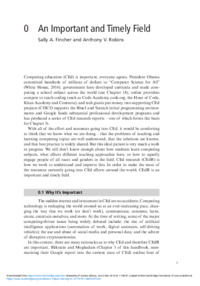An Important and Timely FieldSally Fincher, Anthony V. Robins
Publikationsdatum:
Zu finden in: The Cambridge Handbook of Computing Education Research, 2019
 |
 |
 Diese Seite wurde seit 2 Jahren inhaltlich nicht mehr aktualisiert.
Unter Umständen ist sie nicht mehr aktuell.
Diese Seite wurde seit 2 Jahren inhaltlich nicht mehr aktualisiert.
Unter Umständen ist sie nicht mehr aktuell.
 Zusammenfassungen
Zusammenfassungen
 Computing education (CEd) is important, everyone agrees. President Obama
committed hundreds of millions of dollars to “Computer Science for All”
(White House, 2016); governments have developed curricula and made computing a school subject across the world (see Chapter 18); online providers
compete to teach coding (such as Code Academy, code.org, the Hour of Code,
Khan Academy and Coursera); and tech giants put money into supporting CEd
projects (CISCO supports the BlueJ and Scratch initial programming environments and Google funds substantial professional development programs and
has produced a series of CEd research reports – one of which forms the basis
for Chapter 3).
Computing education (CEd) is important, everyone agrees. President Obama
committed hundreds of millions of dollars to “Computer Science for All”
(White House, 2016); governments have developed curricula and made computing a school subject across the world (see Chapter 18); online providers
compete to teach coding (such as Code Academy, code.org, the Hour of Code,
Khan Academy and Coursera); and tech giants put money into supporting CEd
projects (CISCO supports the BlueJ and Scratch initial programming environments and Google funds substantial professional development programs and
has produced a series of CEd research reports – one of which forms the basis
for Chapter 3).With all of the effort and resources going into Ced, it would be comforting to think that we know what we are doing – that the problems of teaching and learning computing topics are well understood, that the solutions are known, and that best practice is widely shared. But this ideal picture is very much a work in progress. We still don’t know enough about how students learn computing subjects, what effects different teaching approaches have, or how to equally engage people of all races and genders in the field. Ced research (CEdR) is how we work to understand and improve this. In order to make the most of the resources currently going into Ced efforts around the world, CEdR is an important and timely field
 Dieses Kapitel erwähnt ...
Dieses Kapitel erwähnt ...
 Personen KB IB clear | Vicki L. Almstrum , Mark Guzdial , Orit Hazzan , Marian Petre | ||||||||||||||||||
 Begriffe KB IB clear | Informatikcomputer science
, notional machine
,  Programmieren Programmieren programming programming
| ||||||||||||||||||
 Bücher |
| ||||||||||||||||||
 Texte |
|
 Dieses Kapitel erwähnt vermutlich nicht ...
Dieses Kapitel erwähnt vermutlich nicht ... 
 Nicht erwähnte Begriffe | Informatik-Didaktik, Informatik-Unterricht (Fachinformatik) |
 Tagcloud
Tagcloud
 Zitationsgraph
Zitationsgraph
 Zitationsgraph (Beta-Test mit vis.js)
Zitationsgraph (Beta-Test mit vis.js)
 1 Erwähnungen
1 Erwähnungen 
- Past, Present and Future of Computing Education Research (Mikko Apiola, Sonsoles López-Pernas, Mohammed Saqr) (2023)


- The Hands that Made Computing Education Research - Top Authors, Networks, Collaboration and Newcomers (Mikko Apiola, Mohammed Saqr, Sonsoles López-Pernas)


- The Hands that Made Computing Education Research - Top Authors, Networks, Collaboration and Newcomers (Mikko Apiola, Mohammed Saqr, Sonsoles López-Pernas)
 Anderswo finden
Anderswo finden
 Volltext dieses Dokuments
Volltext dieses Dokuments
 Anderswo suchen
Anderswo suchen 
 Beat und dieses Kapitel
Beat und dieses Kapitel
Beat hat Dieses Kapitel während seiner Zeit am Institut für Medien und Schule (IMS) ins Biblionetz aufgenommen. Beat besitzt kein physisches, aber ein digitales Exemplar. (das er aber aus Urheberrechtsgründen nicht einfach weitergeben darf). Aufgrund der wenigen Einträge im Biblionetz scheint er es nicht wirklich gelesen zu haben. Es gibt bisher auch nur wenige Objekte im Biblionetz, die dieses Werk zitieren.









 , 96 kByte)
, 96 kByte)  Biblionetz-History
Biblionetz-History